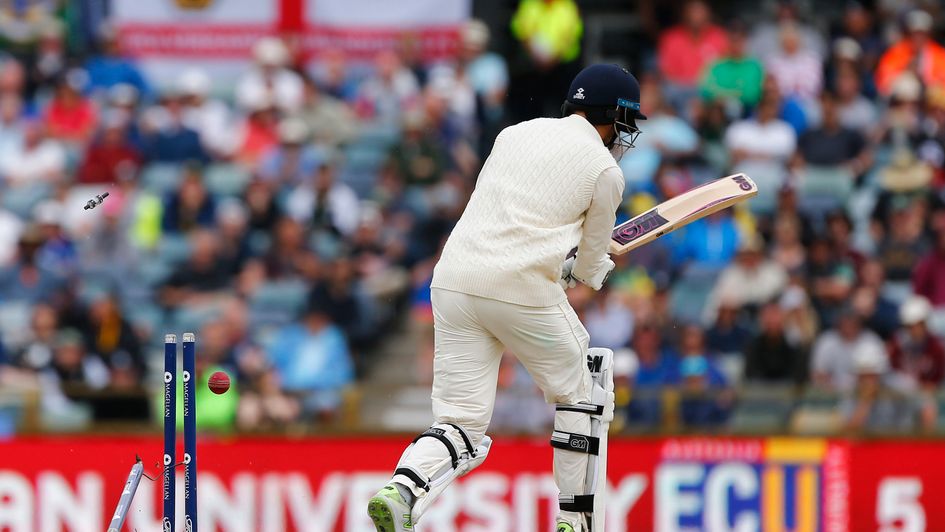Dave Tickner's verdict on day five of the third Ashes Test at the WACA.
Perth Five-fer: Day five
The Thrashes
A brutal, devastating defeat for England who now have an enormous job on to somehow rally themselves for the two holiday Tests and avoid a third whitewash in four Australia tours.
It’s now hard to see them doing so, although Mitchell Starc’s heel injury might help a tiny bit.
The hardest truth for England is that they have had the best of the conditions in all three Tests and ultimately come up woefully short every time. They’ve won the toss three times out of three. They got important first use of the pitch in Brisbane and here, while never having to bat serious time under the lights at Adelaide.
Australia have been better than England in all departments, but the cornerstone of that has been the bowling.
Australia’s bowlers are quicker than England’s, we all know that now and we knew it before the series started.
But pace on its own is nothing. England were (nearly) always able to handle Mitchell Johnson until he harnassed that pace with control and late movement.
That is what England have faced again here. Australia’s bowlers weren’t just quicker, they also got more out of the pitches than England’s. And Nathan Lyon, of course, outbowled Moeen Ali to a truly embarrassing degree, topping it off here by dismissing his nominal spin rival for the fifth time in six innings.
Australia have bowled faster than England - 141.44kph v 135.37kph, found more swing than England - 0.64° v 0.54°, found more spin than England - 4.56° v 3.18°, have middled more balls than England - 228 v 211. They are the better team & have regained the urn. #Ashes
— The Cricket Prof. (@CricProf) December 18, 2017
Australia’s batting has been superior to England’s, but the task facing them has been demonstrably easier than that facing the tourists’ batsmen.
It was the bowlers wot won it.
History repeating
Test cricket has been knocking around for close to 150 years now. This was the 2288th Test match in the format’s long and storied history.
In all that time, and in all those games, six times a team has contrived to score 400 in the first innings and then lose the match by an innings. Three of those six times have been by England in the space of their last five away Test matches.
For Mumbai and Chennai 2016, read Perth 2017.
It’s the Mumbai Test that really provides the blueprint for what we’ve just seen.
A promising maiden century leads England to what must surely be a competitive score.
An all-time great puts that in perspective with a flawless double-century assisted by an unlikely centurion in the middle-order to propel the score beyond 600.
A tired England swiftly lose top-order wickets and, despite a couple of fluent middle-order half-centuries, never really look like getting themselves out of trouble before the tale obligingly and inevitably goes over in a heap. England lose by an innings and 36/41 runs.
It’s just a shame that it was in Chennai where groundstaff had to use charcoals to try and dry the pitch, or this really would have been perfect.
WACA send-off
In the end, the WACA got the Ashes send-off it deserved: England humiliated, Australia winning by miles and regaining the urn in the process.
But for the longest time it looked like this might be a day of ignominy for a great old value.
Now obviously Australia, and Perth in particular, has less rain than England. But it is still ridiculous how poor the pitch coverings are around this country. The soggy hessians and tarps the groundstaff used to try and keep out a forecast storm would shame a mid-sized English club.
The sight of five members of the groundstaff trying to dry out the pitch with leaf-blowers was a ludicrous one.
This was still taking place five minutes before the resumption and was an embarrassing spectacle.
Australia were deserved winners of this Test. It was lucky for the groundstaff that the team won so very convincingly, because there’s little doubt the pitch was demonstrably different on the final day.
There is a very strong argument that there should not have been any play today, a fact reinforced by Jonny Bairstow being instantly dismissed by a grubber that landed right in one of the wet patches the WACA staff had been attempting to remedy.
Had this Test been close, we would be looking at a genuine scandal. Even so, we have certainly not heard the last of it. England can have no complaints about their defeat, but they certainly can about the farcical conditions in which it concluded.
Reward at last
Josh Hazlewood finally got the rewards he’s deserved in this series today, picking up a thoroughly deserved five-wicket haul as his fast-forward impression of Glenn McGrath finally reaped the rewards that had been threatened all series long.
It would help his skipper if he learnt the lbw law, but that’s nit-picking. He barely bowls a bad ball, seems to target the top of off-stump with laser-guided precision and does it all at 88mph.
It only remains for Pat Cummins to get his just rewards with the ball over the final two Tests.
Out of the Ashes...
Now is very much not the time to be taking positives for England. But as in 2013/14 when Ben Stokes’ emergence allowed the tiniest shard of light to penetrate the darkness.
This time it’s Dawid Malan. There have been too many false dawns for batsmen coming into this England side for anyone to be certain that they’ve got one for the long haul, but the signs are good.
The 194 runs Malan made in this Test was the most ever by an England batsmen at Perth, and he is only the fourth England player to pass 50 in both innings of an Ashes Test.
James Vince’s second-innings half-century here also means Malan is likely to be allowed to continue at number five for the last two Tests rather than having to jump up to three as would have been possible had Vince been replaced for Melbourne.
The really exciting thing about Malan is the way his game has grown and improved as the series has gone on. His arrival into the England team is similar to Mark Stoneman’s, getting his chance relatively late in the piece.
Stoneman too has performed well, but while his flaws have been increasingly exposed as the series has progressed Malan has overcome his.
Malan showed promise and fight in the first two Tests of the series, but was too easily tied down. Here he rarely allowed the bowlers to settle in against him. He used his feet well against Nathan Lyon, while against the quick men he looked both more secure in defence and assured in attack.
To learn and improve during a series this tough is a hugely encouraging sign.
Perth Five-fer: Day four
Ball of the century

It’s hard to know what to make of James Vince right now. He still doesn’t really convince as a Test number three, with his habit of nicking off to slip on a very regular basis. Equally he’s played two of England’s most assured innings of the series, neither of which were cut short by his most obvious flaw.
His battling 83 in Brisbane was ended by a daft quick single, while today’s arguably even better 55, an innings marked by a succession of achingly beautiful boundaries, sound defence and good judgement, was only ended by that rarest of things: the truly unplayable delivery.
ICYMI: The ball of the century
— The Ashes on BT Sport (@btsportcricket) December 17, 2017
Mitchell Starc's ridiculous delivery from EVERY angle 😮
Just. Wow.#ItsTheAshes pic.twitter.com/H165bQXTJy
Sent down from round the wicket and heading on its original trajectory two stumps down the legside, it jagged dramatically after hitting a crack outside the right-hander’s off stump to beat James Vince perfectly understandable attempt to play the ball through the legside by about six inches and cannon into the off stump.
It is no exaggeration to say it would’ve dismissed every right-hander who ever picked up a bat. Although Don Bradman and Steve Smith might have nicked it.
50-up
After yesterday’s horror show with the ball, things did at least improve for England. Or, at least, for James Anderson who got the ball full enough to threaten the stumps and extracted just enough movement from the crazy-paving surface to snare both the overnight centurions lbw and return to knock over Pat Cummins and Nathan Lyon before the declaration.
Not for the first time in the series, there was a nagging infuriation that Anderson had not produced this kind of bowling when it might have had a genuine chance of impacting the result, but it was high-class stuff nonetheless at a venue that doesn’t suit him.
He’s now picked up 12 wickets at 26 in the series, not too shabby at all, and 51 at less than 17 apiece for the year.
Brave but foolish
Craig Overton has shown huge promise in his first two Tests, but today may have been guilty of crossing the line between brave and foolish. He bowled well here despite a cracked rib suffered in Adelaide and exacerbated by a failed caught-and-bowled attempt offered by Usman Khawaja in Australia’s first innings.
Today, with Australia’s lead already 220 runs, Overton hared round the boundary and threw himself full length to save a single run.
He left the field, wasn’t seen again during Australia’s innings and is now a serious doubt for the Boxing Day Test at the MCG. Not clever.
Hundred Club
England’s bowling attack became only the eighth in Test history to see five members concede 100 runs in an innings.
The last time it happened in the Ashes was the Cardiff Test in 2009, when two of those bowlers, Anderson and Monty Panesar famously held on for the unlikeliest of draws on the final day.
Good omens, then, for England…
Alastair Cooked?
Is time running out for Alastair Cook? It remains at this stage a decision for him rather than anyone else to make. That’s not because of any “right” to decide the time of his own departure, but rather that England are short of replacements and can ill-afford to jettison his experience or his talent.
If Cook feels his race is run, though, few could blame or begrudge him calling time on a quite stunning career. He will probably only truly be appreciated when he is gone, like South Africans with Graeme Smith.
If, though, the fires still burn bright enough then there is no reason to suppose he can’t emerge from his current trot to recapture his very best form.
At the moment his footwork and technique is all at sea, he seems unsure what to play and what to leave, what to attack and what to defend. Any ball other than one to be clipped off his pads appears a potential source of danger. He has no score above 50 in his last 10 innings.
But he has turned such form around in the past, and done so spectacularly. Can he go to the well one more time?
Perth Five-fer: Day three
Bowled over
A wretched, rotten day for England and no amount of caveats can cover for just how very poor England’s bowling effort was.
Only Craig Overton, comfortably England’s best bowler despite making only his second Test appearance and contending with the considerable discomfort and inconvenience of a cracked rib, deserves to escape censure.
Nobody expected this England attack to turn up and run through Australia’s batting in these conditions. The pitch, ball and weather were all against them. We knew this.
So what, then? Just sack it off? England, barring a fleeting two-over post-lunch spell when Stuart Broad went short at Mitchell Marsh and sent a couple of bouncers whizzing past a couple of flappy hook shots, had nothing to offer.
They just ran up and bowled. Maybe they hoped for mistakes. Maybe they thought they were Homer Simpson against Drederick Tatum and the Australian batsmen would eventually get tired from smashing long-hops and half-volleys around.
It was bafflingly passive. Steve Smith scored a quite brilliant hundred in Brisbane, but boy was he made to work for it. That he had an answer for each of England’s plans was down to his own other-worldly brilliance rather than any fundamental flaw in those plans.
In Adelaide England got in his head and he failed twice.
Here, they just left him to it. This century was as effortlessly brilliant as Brisbane’s was industriously so. They are his quickest and slowest respectively in Tests, and that is not entirely down to the conditions or situation.
Had England been warned off by coaches or officials about going after Smith verbally as they had in Adelaide? It seems the only logical explanation for their failure to do repeat a plan that apparently worked so well, albeit in very different conditions. It’s not like he walked to the crease yesterday with Australia already in total control; England had just struck twice to leave Australia 55-2 in reply to 403.
The upshot of England’s batting collapse and inexplicable lethargy in the field saw them turn a first-innings 368-4 into almost certain, series-conceding defeat in the space of four sessions.
Platitudes about the bowlers trying their best and never giving up can get in the bin. This just wasn’t good enough.
Record-breaker
England may not have made it as hard for him as they could have, but that’s for them to worry about, not him.
This was the latest remarkable chapter in an increasingly astonishing career. He and Virat Kohli have already turned the Big Four into a Big Two, and the only surprising thing about this double-century was the fact it is only his second Test double. It had appeared inevitable from sometime yesterday afternoon.
England just had no answer to an idiosyncratic but utterly ruthless Test run-scoring machine. At one point, the stat-boffins revealed he had played and missed at four of the 280 deliveries England sent down. Eliminating error to this extent while continuing to score runs freely is simply staggering.
The records he is breaking are now stratospheric. He has now scored 1000 Test runs for the fourth consecutive year. Only Matthew Hayden has ever done that before.
But that’s nothing. He now sits second in the all-time averages table behind only Sir Don Bradman. His 73-run average as captain is again second only to the Don. Nobody, bar the Don, has ever scored more runs in their first 108 Test innings than Smith. Right now, Smith is in a class of his own behind a man with the most freakishly pre-eminent statistical dominance in any sport, not just cricket.
There is no doubt he must now be considered the greatest Test batsman of the modern age. It is testament to Kohli’s own genius that he has been able to sustain the debate where other undoubtedly great but now undoubtedly lesser talents like Joe Root and Kane Williamson have not.
Marsh attacks

It’s therefore also testament to the innings Mitchell Marsh played that it was easy to argue Smith was only the second most impressive batsman on display today.
England may have offered Marsh countless early Christmas presents throughout their miserable day in the dirt, but you still have to open them.
Marsh was solid in defence and destructive on the drive, pull and cut on the all too frequent occasions when England went too full, too short or got their lines wrong.
At no stage did he ever resemble a batsman with a Test average of 20-odd. His booming drives suggested a Shane Watson who had learned to bat for longer than two hours.
Chalk up another big tick for the Aussie selectors, who once again had plenty of assistance from England along the way.
What now?
Barring a five-session rearguard that shouldn’t be entirely ruled out on a pitch that will have big cracks but few demons over the last two days, England will, for the third time in four tours, leave Perth having surrendered the urn before Christmas.
The gut-punch about this series is that England have had more good sessions and more good days than in either 2006 or 2013. They just haven’t been able to string enough of them together or, when they have, it’s already been too late.
The Adelaide Test remains the one that got away, where Joe Root’s questionable decision to bowl first was made to look far worse than it was by a shoddy performance with the new ball. England fought back gamely but left themselves too much to do.
If they do lose here, then at least they can refocus on the one remaining goal without pretending that talking about a whitewash might magic it into being.
This remains a team capable of beating Australia if enough players stand up in the same Test.
Careers on the line
Looking further ahead, this performance is already starting to feel like one that, rightly or wrongly, ends careers.
The 2013/14 series ended or significantly curtailed plenty of careers, and there must now be fears that the same will happen here.
Alastair Cook, Stuart Broad and James Anderson are playing their 100th Test together here, only the third trio – and the first not featuring Rahul Dravid and Sachin Tendulkar – to do so. None are fighting for their careers exactly. There is nobody to replace any of them, for a start, and all have more than enough credit in the bank to continue.
The fight, if it exists, is internal. It would no longer be a surprise to see one or more of a trio who have achieved more than almost anyone else in English Test history call it a day.
England must hope they retain the desire to play on; if nothing else, there’s an urn to regain in a tantalising 18 months’ time. Cook is still the best English opening batsman around – check out the County Championship stats for confirmation. Anderson, outrageously, remains if anything on an upward curve at 35 years old having averaged in the low 20s each year between 2014 and 2016 and still way under 20 this year.
Perth Five-fer: Day two

Half-full or half-empty?
England’s innings was a riddle wrapped in an enigma. How to judge it?
Would England have taken 403 at the toss? Yes, given they had reached 400 only once in 17 Ashes Tests since 2010/11.
Would England have taken 403 at 131-4? Absolutely yes.
Would England have taken 403 at 368-4? Let’s go with no.
But let’s also not get carried away. There were suggestions that the blame for England’s collapse lay at Dawid Malan’s door. Yes, the dominant partner in England’s best-ever fifth-wicket partnership against Australia. I’m inclined to give him more credit for turning 131-4 into 400 than brickbats for not turning 368-4 in to 500 or more.
The responsibility to turn a wonderful platform into something more substantial still does not rest solely with those who built it. Malan fell to an attacking shot at a time when he and Bairstow rightly looked to dominate.
While the ensuing collapse was not surprising, it seems perverse for Malan to shoulder the burden for Moeen Ali and Chris Woakes wandering out there and being surprised that the ball bounced.
England’s big problem, predictably, was that ultimately 403 looked like a very decent score in these conditions against Australia’s pace attack yet vaguely inadequate against England’s fast-mediums.
Head strong
Jonny Bairstow followed Malan to three-figures before eventually once again getting out trying to winkle out some runs alongside England’s shambolically flimsy tail.
It was a wonderful innings, fully justifying his move up the order. He may yet find himself moving another place up the order – and perhaps even sacrificing the gloves – should the selectors lose patience with James Vince’s Groundhog Day Test career.
But back to the 119 Bairstow made here. There was so much to like. For the first time in the series he had the freedom to play, for the most part, as a proper batsman. And he did so gloriously. He was patient and watchful when necessary, going through the gears whenever possible and rarely looking anything like fully in control of his game and emotions.
Better than all that, though, was his celebration as he headbutted his England batting helmet in celebration to firmly condemn Australia’s cynical attempt to humiliate him to history. There was no fake laughter from Smith during Bairstow’s innings.
Smith genius
However well Malan and Bairstow batted – and they batted quite beautifully – they were immediately and thoroughly upstaged by Smith.
From the moment he reached about 20 there seemed to be an air of absolute certainty about his century. It was just a surprise that he didn’t manage to get there before stumps, but he’ll be there tomorrow to complete the formalities.
The conditions were ideal for him. A pitch with pace and bounce but no lateral movement, and an opposition attack without the pace to trouble him
But even so, the plane on which he operated was so far elevated from anything else we’ve seen in the series to date was quite extraordinary.
The only ball in the entire innings that missed the middle of his bat was a rogue lifter from Craig Overton from the final ball before tea that leapt from a crack and hit the Australian captain on the thumb and chin. Even then he was alert enough to divert the ball away from his stumps.
There was nothing else that troubled him. For all his fidgets and trigger movements and rotary backlift, he always gets in a wonderful position by the time he actually comes to play a shot.
His head position is exemplary, his hands and eye outrageous and his ability to find the gaps almost uncanny.
In Brisbane England at least managed to keep him under control. In Adelaide they got in his head. Here they had no answer. He toyed with bowlers and fielders alike.
On any pitch against any attack to score 92 runs from 122 balls without ever appearing to take a risk or play a false shot or even appear in any kind of discomfort at all is absolutely outrageous. An absolute freak of a batsman.
On review
The DRS has come in for plenty of criticism in this series. The players no longer seem convinced by it.
I’m not sure why. It seems to be working perfectly well.
There was no better illustration of this than Cameron Bancroft’s dismissal here to Craig Overton, comfortably the best of England’s bowlers before an injury that could severely hamper the tourists’ chances of taking something from the game.
Marais Erasmus’ initial not out decision was entirely understandable; for a start there were two noises, and there had to be some doubt in the umpire’s mind about whether the ball had hit the batsman in line.
Replays quickly showed the two noises to be bat on pad and ball on pad. Ball-tracking technology confirmed the rest. And there you have it. An on-field decision you could perfectly understand, but one conclusively shown to be incorrect.
Usman Khawaja may feel hard done to by his lbw dismissal late in the day, but any doubt around that wicket came from the original on-field decision. It was marginal on field, and remained marginal – not wrong - with technology.
New balance
With 403 playing 203-3 we’ve got one of those interesting scorelines where a genuine debate can be ahead about who’s ahead, about which dressing room you’d rather be in.
On the one hand, England have runs on the board. On the other, they face the prospect of one of those nasty third innings where the tempo is so hard to get right and the prospect of undoing three-and-a-half days’ hard work in a session brings its own pressures.
In truth, though, right now the answer is simple. Steve Smith is not out. Therefore you’d rather be in Australia’s position. Right now, that is almost always going to the case.
Perth Five-fer: Day one

New life
We absolutely must not get carried away. The pitch may have pace and it may have bounce but it is also true. There was no seam movement to speak of, the new ball swing lasted for about two lots of three overs and the reverse-swing was negligible. The outfield is ludicrously fast. England may yet crumble to 350 all out tomorrow morning and don't have the pace Australia possess to create something when the conditions offer nothing..
But this was the day England and this series needed. From the creeping threat of yet another whitewash, England have now pushed Australia out to 3/1 – outsiders of three – just to keep their hopes of it alive at Christmas.
England did the three things they absolutely had to do today: win the toss, bat first, and bat well.
It’s no exaggeration to say this was the best day England have had in Australia since the innings victory at Sydney in the early days of 2011, when the Aussies’ meek surrender was only briefly delayed by an enterprising unbeaten 50 from legspinning all-rounder and comedy selection Steve Smith. What did happen to that guy?
Enter Malan
But it could all have been very, very different. England have spent much of this series getting themselves into decent positions and then chucking them away. It’s been quite infuriating.
Today could have been another such day. They had recovered from the early loss of Alastair Cook and were minutes away from lunch at a healthy 89-1 before James Vince, having stoically resisted James Vincing for almost two hours, could resist no longer and James Vinced a catch to Tim Paine.
When 89-1 became 115-3 shortly after lunch with the loss of Root, Dawid Malan strode to the middle with England in very real danger of tossing it all away once more.
Then came the dismissal of Mark Stoneman – of which more later – to make it 131-4. A crucial moment, the distraction of the nature of the dismissal, and a batsman who was still yet to go past 65 in Test cricket.
What Malan did, in that context, is therefore remarkable. It was not a chanceless knock, and it was not without its moments of fortune. But on a fast pitch against this attack, it would be hard to begrudge the odd moment.
And that’s all they were. Malan had a clear plan against every bowlers, and helped along by the pace of the pitch and outfield, never got bogged down as he had in promising but ultimately inconsequential efforts at both Brisbane and Adelaide.
His driving through the covers in particular was crisp, efficient and effective. He knew there was no need to overhit the ball in the conditions, and he was more willing than any other player to take on as well as evade the short ball.
A 30-year-old cannot be described as a youngster, but he is still young at this level. This was an innings of rare assurance for a maiden Test century and it could yet on this evidence be the first of many.
England batsmen tend to burn out rather than fade away, with the years spent specifically on the international treadmill more significant than the total years spent on the planet.
As such, 30-year-old Malan can look ahead to plenty more years in an England shirt while 32-year-old Cook can look (if not yet sound) close to the end.
Sliding Doors
The great thing about a day like today is that six-and-a-half hours of hard yakka can pivot on a single moment. There is so often one incident, often seemingly minor, that can take on huge significance as the bigger picture emerges.
One such occurred today when, early in his own innings and with Malan having made the sort of 32 we’ve seen plenty of times from him already, Jonny Bairstow called for a dodgy single.
The run wasn’t really on to any fielder, least of all David Warner who swooped from cover and, despite a decent target to aim at, dragged his throw wide of the stumps with Malan well short of his ground.
That would have made the score 150-5 with half the day remaining. Instead, Malan and Bairstow turned that 19-run stand into a still-unbroken 174. It is the reason this series remains still, just about, alive.
Stoneman, DRS and the short ball
For much of the day the crucial moment looked sure to be the dismissal of Mark Stoneman caught behind off Mitchell Starc. There are a couple of things to note that got lost among the brouhaha: one, it was a brute of a delivery and two, it was a stunning grab from Tim Paine one-handed high above his head.
Those two things were quickly forgotten in the sort of mess cricket absolutely thrives on, in which much anger, confusion and vexation arrives from a decision that was actually correct.
The facts were these. The ball flicked Mark Stoneman’s top glove as it roared past his face on its way to the keeper. Marais Erasmus, understandably enough, failed to detect this. Aleem Dar, though, saw enough on snicko to swiftly overturn the decision.
It was a hasty decision made on imperfect evidence. The “spin-vision” close-up camera shot tracking the ball’s path was unavailable. Hot Spot got nothing. And there were a lot of moving parts around masking the ball on the shots that accompanied the snicko wave.
Dar’s decision fell into the “educated guess” category. From the various pieces of evidence available, by far the most plausible explanation was that the ball had indeed flicked the glove. But there was no single piece of evidence that conclusively proved this. Did he have enough evidence to overturn an on-field decision?
Aleem Dar thought he did, and subsequently broadcast replays from different angles suggested he was right.
England, though, were incensed to the extent Stoneman – who probably knew he’d gloved it and was in any case happy enough to accept the decision when it was handed down – was urged not to leave the field of play by Joe Root and others on the England balcony.
This was in itself a quite amusing and vaguely embarrassing moment, but the really interesting thing is that it suggests the England players don’t know that the laws regarding dismissals have changed: previously, a player could not be recalled once he’d left the field but now a dismissal is only rubber-stamped and irreversible once the next ball is delivered.
Most importantly for the DRS in the long-term, it suggested a group of players starting to lose faith in a system that actually still works well.
Hot Spot's failure to record Stoneman's glove here and Chris Woakes' fine edge on the final day in Adelaide are the only two genuine failures of the system, and Hot Spot has always been a tool that can prove something happened but not that it didn't.
For Stoneman, though, there is a wider issue. Whatever the rights and (dubious) wrongs of his dismissal, it came when he tried to stand tall and play the short ball. It’s not a great option.
He doesn’t really pull or hook, and nor does he really duck and sway. He is clearly a teak-tough competitor, and showed as much here by batting on after a crunching direct hit on the side of his grille among other blows to the body and hands.
But while the physical peril may not bother him, the risk of losing his wicket should. He had already spooned, fended, spliced and gloved several deliveries before his eventual dismissal.
He looks by far the most assured of Cook’s various post-Strauss opening partners, but his technique against the short ball needs work.
Lyon taming
Among the various encouraging factors for England today was the fact Nathan Lyon – who has caused them every bit as much trouble as any of the three big quicks – took no wickets and perhaps even more importantly bowled only four maidens and went for 61 runs in his 19 overs.
Yes, Perth is less helpful for him than either Brisbane or Adelaide but England’s approach was still refreshing.
It was clear the need to tame Lyon had been discussed and every batsman had a plan. Stoneman swept him, Vince and Malan used their feet to hit him straight.
Malan in particular was then swift to rock back and take advantage of the inconsistency in length that his fleet footwork had precipitated.
In Perth, the scene of Bairstow’s “headbutt” and Ben Duckett’s wastefulness, an England squad portrayed in the build-up as a drunken mob of daft students showed they had been doing their homework after all.









